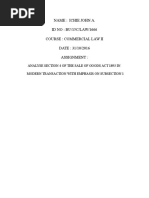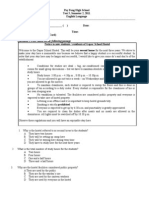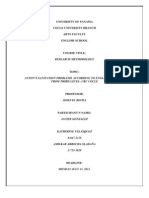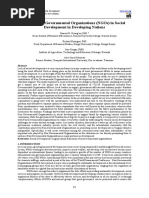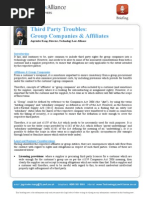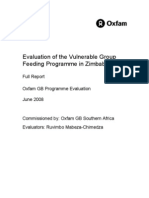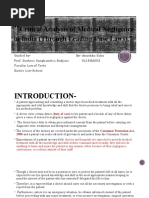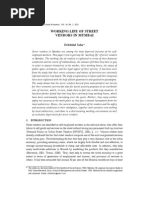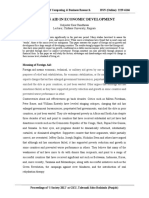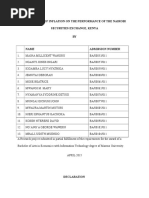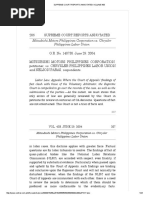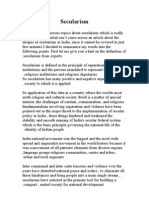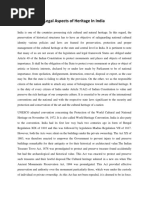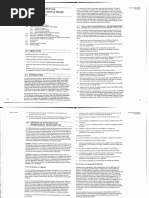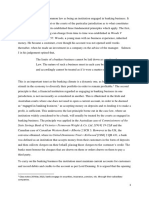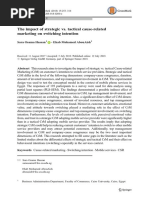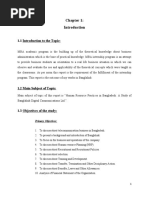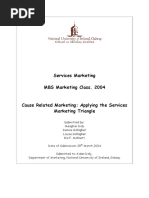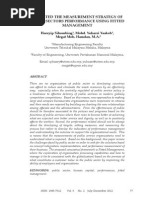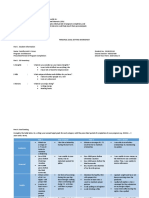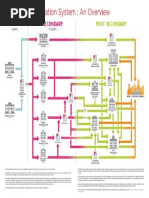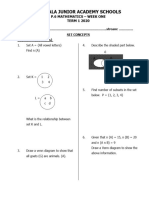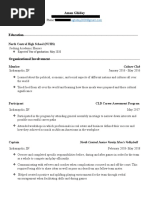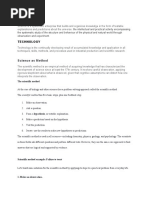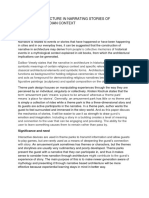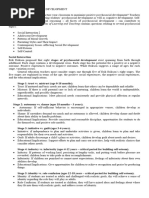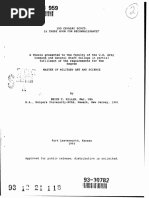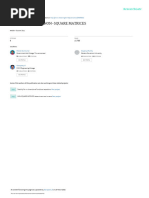Research Proposal
Research Proposal
Uploaded by
Matthew Wade PadgettCopyright:
Available Formats
Research Proposal
Research Proposal
Uploaded by
Matthew Wade PadgettOriginal Description:
Copyright
Available Formats
Share this document
Did you find this document useful?
Is this content inappropriate?
Copyright:
Available Formats
Research Proposal
Research Proposal
Uploaded by
Matthew Wade PadgettCopyright:
Available Formats
PROJECT PROPOSAL Running head: PROJECT PROPOSAL
Project Proposal: The Usefulness of Internal Marketing in Local Government Image Building
Gerald Seals Newberry College Submitted in partial fulfillment of the requirements for BUA 472 Organizational Behavior February 6, 2013
Quarter and Year: Spring, 2012 Address: 2100 College Street City, State, Zip: Newberry, SC 29108 Phone: 864-350-7070 E-mail: Gerald.seals@newberry.edu Instructor: Prof. D. Mans Excellence
PROJECT PROPOSAL Abstract
Presented is a proposal to examine the merits of internal marketing to improve the image and service delivery performance of local government organizations. The logistical layout of the proposal begins with an introductory discussion followed by definition contained within a review of the internal marketing literature. A methodological discussion follows about internal marketing as a competitive advantage. The follow-on discussion of internal marketing mix notes the symbiotic relation extant between internal marketing and external marketing. Also discussed thereafter are research methodologies, the role of environment, and environment forces within the context of internal marketing. Although research methodologies is discussed earlier in the paper, due to it being identified as a specific topical question, the proposal ends with a brief discussion committing to the conduct of an environmental analysis to identify opportunities and threats in the marketplace and strengths and weaknesses of the local government organization using the internal marketing paradigm.
PROJECT PROPOSAL The Usefulness of Internal Marketing in Local Government Image Building
Berthon and Katsikeas (1998) wrote that a sense of urgency, they characterized as the ephemeral now, now characterizes society and organizations. Kreigel and Brandt (1996) lamented everyone is restructuring, reorganizing, reinventing, downsizing, outsourcing-all at an ultrasonic pace (p. 2). While various scholars, historically, to explain the sheer complexity of organizations and promote service delivery excellence, suggested a variety of theories, the citizen-customers of government rarely regard local government as service delivery excellent. The image citizen-customers have of their local government is in large part due to their interactions with the employees of that government (Lee, 1998). Lewis and Entwistle (1990) concluded that when it comes to services, customer satisfaction and customer dissatisfaction occurs when front-line employee and customer interact. In other words, there is a causal link between external customer satisfaction and the contribution made by the customer contact employee providing the service (Taylor and Baker, 1994). Noting that causal link, Bansal, Mendelson, and Sharma (2001) recommended that businesses develop marketing programs for contemporaneous application to its internal market and external market. It seems reasonable to assume that this causal link extends to local government where the predominant service delivery model mimics the service sector. The question, Are the employees oriented and attuned to serve according to citizencustomer expectations? is a question that underlays this proposal. According to Kotler and Levy (1969), because "everything about an organization talks (p. 13)," each organization-public contact leaves citizen-customers with an image of that government. Grunig (1997) also noted that the image citizens have of their local government is due in significant part to their
PROJECT PROPOSAL
interactions with government employees, but went further to note that governmental employees are not often aware of their role in creating image. Given the local government service similarity to service sector services, this proposal suggests that internal marketing may likewise offer to local government the tool for improving service delivery. While there is an apparent dearth of literature specifically discussing the application of internal marketing in local government, this proposal recognizes and the larger paper will discuss the similarities between public and service sectors. Using findings gleaned from the scholarly literature it seeks to develop an internal marketing strategy for instilling a customer service mindset in government employees. It begins with a review of the literature, noting, inter alia, operational definitions for marketing and internal marketing. Next, because, according to Luan and Sudhir (2010), methodology is a requisite of good marketing strategy, the proposal discusses research methodologies identified in marketing literature that will eventually underlie the marketing strategy. How to bring about such organization-wide recognition and reorient employees to adopt a customer-service orientation is the ultimate goal of this proposal and the larger paper. This proposal includes a brief discussion of the internal marketing environment and the forces that impact environment. Accordingly, the final project is will conduct an analysis of the external and internal forces affecting a local government organization. The role of segmentation in the proposed internal marketing strategy formulation will also be included. The final project will then suggest an internal marketing model for local governments. Literature Review
The literature contains several definitions of internal marketing. According to Ahmed and Rafiq (2002), internal marketing is a planned effort using a marketing-like approach directed
PROJECT PROPOSAL
at motivating employees, for implementing and integrating organizational strategies towards customer orientation. Hogg and Carter (2000) noted the dependent relationship between internal marketing and market orientation in that organizational values are actually communicated using marketing techniques deployed within the organization.
The research of Anderson (1966), Kotler and Levy (1969), and Lee (1998) revealed that it is now commonplace for local governments to market themselves to their citizen-customers. The clear implication is that the current recessionary fiscal climate and an increasingly cynical but demanding citizenry necessitate a more market orientation by local governments in the delivery of their services. Flattened organizational structures have been replacing hierarchical structures and government executives expect employees to be customer-centric and efficient. No longer are consumers of government services citizens, they are customers who consume and pay for, via fees and taxes, local government goods, services, and ideals. In such an environment, local government must create an image in the minds of its customers, who are residents, business owners, and employees (Lee, 1998). Trueman, Klemm, and Giroud (2004) made the case that poor perceptions of a city can devalue its image and have far reaching consequences for future prosperity. These negative associations may reduce the likelihood of inward investment, undermine business community activities and have a detrimental effect on the number of visitors, thereby exacerbating urban decline (p. 317). Installing customer oriented service delivery or creating a customer-centric organization, was a central tenet of the authors leadership of the government of Greenville County from 1994 until 2000 and is today a common goal of local government executives (McCallum, Spencer, & Wyly, 2005, p. 25). Hatch and Schultz (2008) noted that customer-centric reveals itself via the organizational engagement of the following six tactics: branding, media relations, in-house publications, use of outside organizations or
PROJECT PROPOSAL
volunteers as public relations tools, public art, and built environment via sustainability. The larger paper will include a detailed discussion of each of the six tactics. Lee (2000) distinguished the first three as the more common tactics of governmental public relations. Anecdotally, the authors personal experiences affirm the challenging nature attendant to installing and instilling this customer service mindset within local government. The work of several researchers, for example, Berry, Conant, and Parasuraman (1991), Heskett, James, Jones, Loverman, Sasser, and Schlesinger (1994), and Berry (2002) revealed that internal marketing has been an effective tool deployed in the private sector to encourage frontline employee high performance by being supportive of their needs and in turn facilitating exceptional service to fellow employees and customers. The research of Tansuhaj, Randall and McCullough (1991) revealed a customer service mindset actually facilitates job satisfaction. Rafig and Ahmed (2000) and Conduit and Movondo (2001) found a positive relation between the deployment of internal marketing and customer-centric orientation and performance of service organizations.
Internal Market as a Competitive Advantage
Competitive advantage exists when the strategy used by and organization may not be imitated by competitors, or will take the competitors a high cost to imitate (Hitt, Ireland, and Hoskisson, 2007). An organization with competitive advantage performs specific tasks with greater efficiency than competitors or performs tasks at a level of quality not replicable by competitors (Hitt, Miller, and Coella, 2006). While it is accurate that local governments, for most services, operate in a monopoly environment, it is possible to establish a benchmark for those services. By performing more effectively than provides subject to the benchmark, the organization will be able to provide more valuable products and services to the customers. The
PROJECT PROPOSAL
competitive advantage, the resources and the capabilities of an organization is valuable, rare, irreplaceable and incapable of being imitated (Hitt et al., 2007). Therefore, the definition of competitive advantage includes a skillful, motivated and flexible workforce in addition to technology and economic scale.
Piercy (2002) noted that internal marketing has the goal of developing a type of marketing program that is aimed at the internal marketplace in the company that parallels and matches the marketing program aimed at the external marketplace of customers and competitors. Hitt, Ireland and Hoskisson (2007) identified internal marketing as a competitive advantage since it concerns itself with becoming a customer-centric as a core competency. Greene, Walls and Schrest (1994) noted that internal marketing is a key to successfully serving the external customers of an organization. Berry (1980) noted that The same marketing tools used to draw bank customers can serve to attract and retain the best employees, and earn the best performance from them (p. 33). Gronroos (1981) viewed internal marketing as a means through which employees may attain workplace satisfaction and a customer-centric demeanor and outlook. This is because the organization recognizes and treats employees as constituting the organizations internal market and meeting the needs of the internal customers is essential to the success of the organization in external market.
Varey (1995) and Cahill (1995) viewed employees as human capital and it is that the source of sustainable value for an organization is human capital coupled with intangible assets. Gronross (2000) noted that internal marketing focuses on establishing proper internal relations within each organization, which promote a customer-centric approach to service between employees and external customers.
PROJECT PROPOSAL Internal Marketing Mix
Piercy and Morgan (1991) and Rafiq and Ahmed (1993) elaborated on the concept of internal marketing noting the existence of internal marketing mixture, which is the using internal distribution, communication, price and product will facilitate the process of organizational change through techniques and systems, the structure of power and political culture inside the organization. Rafiq and Ahmed (1993) specifically the internal marketing mix as the values and attitudes needed by employees to achieve successful marketing strategies and training courses to promote the knowledge of the internal customers. Price, therefore, for example, they defined as an expense that the employees make to obtain new knowledge. Internal promotion has been considered as an effective relation with the employees, such as using face-to-face interactions, recognition and reward systems. They also pointed out to the means of products distribution to the internal customers as an internal place. These means of distribution may be presented in such forms as official meetings and using consultants to provide advanced inter-organizational training. The Rafiq and Ahmed (2000) analysis also noted that marketings four Ps applies in the internal marketing dynamic in a typical organization.
Kotler and Armstrong (1999) argued that internal marketing facilitates value internally and externally to the organization. Internal marketing and external marketing therefore exist symbiotically but are different in the internal marketing mix. Specifically, internal marketing focuses on internal market and external marketing focuses on external customers and market. Product is a key element of the external marketing mixture. In internal marketing, product exists on three levels: fundamental, strategic and duty. At the fundamental level product is a job. At the
PROJECT PROPOSAL
strategic level, product includes values and attitudes extant in the organization. At the duty level product consists of any functional measures and customer management.
Research Methodologies Identified in Marketing Literature According to The American Marketing Association (2007) marketing research "links the consumer, customer, and public to the marketer through informationinformation used to identify and define marketing opportunities and problems; generate, refine, and evaluate marketing actions; monitor marketing performance; and improve understanding of marketing as a process." Quantitative research when compared to qualitative research, not only investigates activity, it seeks behavioral and attitudinal validation through the measuring and tracking of occurrences and/or responses to arrive at projections and predictions. In a 2004 white paper, Merkle Thought Leadership Series defined quantitative marketing as the utilization of facts and knowledge to better understand the behaviors of consumers across the marketing enterprise to maximize marketing investment (p. 4). Parasuraman, Grewal, and Krishnan (2007) defined marketing research as a set of techniques and principles for collecting and analyzing data in order to facilitate decision making about marketing the products, services, or ideas of an organization (p. 9). The several approaches that constitute the portfolio of techniques include observational research, experiments, ethnographic research, and survey research (Tyagi, 2010).
The goal of market research is to provide an organization with information about customers, competitors, and the environment in which it operates in order that it may achieve competitive advantage. Perhaps the fundamental issues undergirding this discussion is marketings search for a definitive means through which organizations may decide the amount of money and level of resources to allocate to influencing the purchase behavior of consumers to
PROJECT PROPOSAL
10
generate sales to achieve the profit goals of the organization (Farris, Bendle, Pfeifer, and Reibstein, 2006, p. 19). Willis and Webb (2006) correctly noted that first-class customer insight is requisite for strategic planning and marketing if a business is to maximize its revenue generating opportunities. Attaining the necessary data attendant to customer insight is possible through a variety of analytical methodologies, two of which, qualitative and systems theory, are the subject of this post. Specifically, this post cites definitions qualitative analysis and systems theory offered in the literature, noting contrasts, similarities, and divergences. Whitchurch and Constatine (1993) defined systems theory as the basic notion that objects extant in the world are interrelated and that the relationships may be investigated using mathematical models. This definition is derivative of that originally expressed, according to Kaszlo (2003) by Ludwid von Bertalanffy. A quick re-reading of Bertalanffys book, General System Theory, revealed him a biologist whose formulation derived from his work in general system theory (1968). Merker and Lusher (1987) saw in systems theory a means to evaluate and attain understanding of organizations, particularly in terms of organizational effectiveness viewed via its structure and processes. Reidenback and Olivia (1981) previously noted systems theory offered promise as a marketing analytical tool and methodology for inducing, transducing, exploring, maximizing, and tracking consumer consumption. It is, however, not econometrically dependent. Quantitative research methodologies are fundamentally deductive, that is deploying econometrics and mathematical modeling to formulate or postulate a theory or hypothesis to observation. Central to quantitative marketing is the utilization of facts and knowledge to better understand the behaviors of consumers across the marketing enterprise to maximize marketing
PROJECT PROPOSAL investment (Merkle Thought Leadership Series, 2004, p. 4). It is an examination of a
11
snapshot. Quantitative methodologies are especially suitable when applied to issues well defined in scope and scale (Churchill, 1995; Craig and Douglas, 2001). This approach stands in stark contrast to the inductive, analysis as a function of moving from observation to theory postulation, character of qualitative research methodologies. Qualitative research proceeds from a epistemological underpinning different from quantitative methodologies that consumer information is social and not technical (Robertshaw, 2007). Qualitative research, somewhat similar to systems theory, does not depend on statistical analysis but, epistemologically, relies heavily on analysis based on general observations, there from which emerges a general theory. The process is dynamic and organic due to the complexity attendant to human behaviors. Qualitative research techniques are typically unstructured and include such exploratory techniques as group discussions and in-depth interviews (Maxwell, 1997). In something of a divergence from qualitative research, systems theory clinically studies such factors as technology, behavior, or environment. Qualitative research is field based and dependent on high interaction between researcher and researched (Mellow and Flint, 2009). Maxwell (1997) identified circumstances that warrant qualitative methodologies: the need to understand meaning that underlay events, activities, situations, and behaviors; the need to understand context and the role of influence; the need to understand and postulate grounded theories regarding unanticipated phenomena; the need to understand the relationship between process and outcome; and, the need to understand causal relationships and provide causal explanations. Fielding (2007), discussing the merits of consumer research panels, also acknowledged the importance of interaction between researcher and phenomena under study and that that interaction should not be avoided or dissuaded. Social opportunities should be
PROJECT PROPOSAL
12
embraced as a potential source of valuable information for analysis to determine the genesis of a matter (Mellow and Flint, 2009). Ruyter and Scholl (1998) concluded that qualitative methodologies may actually help decision-makers and researchers decipher and uncover meaning that may underlay numbers. As noted earlier, a review of the literature revealed little research about the application of internal marketing in local government; instead, empirical research tended to address the service sector. To measure internal marketing, Foreman and Money (1995) and Money and Foreman (1996) developed a 15-item questionnaire consisting of three underlying factors vision (giving employees something to believe in), development (items having to do with rewarding employees) and reward (items having to do with developing employees). Caruana and Calleya (1998) and Ewing and Caruana (1999) applied this questionnaire in their respective empirical surveys. Quester and Kelly (1999) noted the importance of inclusiveness and organization-wide commitment when they concluded, the implementation of IM is carried by a combination of people such as the marketing manager, the managing director and particularly the human resources manager who are highly involved in planning IM (p.224). In the final paper, the author will utilize remote environment, industry environment, and operating environment analysis, formally called environmental analysis, since it permits analysis of both external and internal forces impacting an organization. The remote environment analysis examines factors external to the business that affect the business. The remote environment is comprised of five factors: political, economic, social, technological, and ecological. Political factors include laws, regulations, and governmental policies. Economic factors include local and national market conditions, unemployment rates and interest rates. Social factors include values, beliefs, and lifestyles choices that impact the market. Ecological factors include environmental
PROJECT PROPOSAL
13
concerns and such thinks as global warming, and conservation efforts. The industry environment analysis examines competition. The operating environment analysis is the final step. Internal and External Forces Forces from outside and inside impact organization, often necessitating change (Brown and Eisenhardt, 1998).Oakland and Tanner (2007) identified stakeholder demands, customer demands, regulatory demands, market competition, and shareholder demands as the primary external forces that affect organizations. Regarding internal forces, Oakland and Tanner (2007) identified the need for process improvements, the need for increased operational efficiency, and the need for increased quality in products and services. According to Oakland and Tanner (p. 119) identified four major external forces: demographic, technological, market changes, and social and political pressures. Internal forces emanate from within an organization and include low morale, low productivity, or conflict (p. 1-19). Huy (2001) noted that leaders of organizations must seek to attain understanding of these forces since, no matter how unsettling, intimidating, or uncomfortable, they can have a profound effect on the organization. The author proposes to discuss in the larger paper how external and internal forces may marketing strategy. For example, Howell (2005) noted that employees tend to resist change brought on by marketing research. Goodman and Rousseau (2004) noted this is because many employees regard any change, even that based on study, as inconvenience and fear of uncertainty. Recardo (1991) noted the existence of eight tactics that organizations should deploy to effect excellent service delivery: education of the workforce, provide dialogue communication, use and involve impacted groups, provide a merit reward system, avoid mixed signals, and modify subsystems to effect self-determinant decision making, and supply adequate resources. The larger paper will
PROJECT PROPOSAL use Lewin (1964) change model to review the impact of internal and external forces on marketing strategy. Internal Marketing Environment
14
A tenet of internal marketing is that the operational effectiveness of management functions of organizations are enhanced when they operate in union and alliance (Ahmed and Rafiq, 2003). A key success indicator for any organization is products and/or services supported by the customers of that organization. Marketers therefore focus on creating value for and building meaningful relationships with customers, endeavors that require marketers to attain insight into what customers need and want. Fundamentally, the process for creating value and building relationships with customers require information about existing and prospective customers and current and future value (Sawhney, Schieffer and Leininger, 2008, p.3137). Quantitative analytical techniques are rooted in the importance of understanding the consumer and therefore have emerged as perhaps the most state-of-the-art tool for attaining an understanding of consumers. [T]ransforming todays vast, ever-increasing volume of consumer information into actionable marketing insightsis the number one challenge for marketers (Fassnacht, 2007 p.15). When contrasted with qualitative techniques, with its emphasis on process and direct interaction with those under study, quantitative techniques focus on attaining quantifiable, reliable data that can be generalizable to either an existing base of customers or a target customer base. In other words, the quantitative paradigm has its significant advantages, inter alia, being more efficient, timely, and cost-effective (Gelb 2006).
PROJECT PROPOSAL
15
Thus, it becomes necessary to attain an understanding of the internal market environment. Internal marketing acknowledges the value of an environment of inclusiveness and participation. This is the essential conclusion of the Ahmed and Rafiq (2003) research, that organizational success requires that every employee is involved in and committed to the high performance through the customer-supplier chain. Gounaris (2008) thus noted internal marketing relies on satisfying employee needs antecedent and as a facilitating requisite to satisfying customer needs. Intuitively, market area rules therefore apply to the internal market of the organization. Voss, Calantone, and Keller (2005) rightly concluded that employees are the internal suppliers and customers of the business and that the internal market of an organization encompasses its employees. By application and extension, managers in local government must create a similar internal environment supportive and empowering of customer centered employees. External Environment and Markets Critical to the analysis are definitions for organization, environment, and organizational effectiveness. Cherrington (1989) defined an organization as an open social system wherein the patterned activities of goal-directed people occur. A system, open or closed, acquires inputs from the environment and transforms those elements into outputs that the environment acquires. Patterned activities are events that occur with consistency and regularity. Viewing this interaction between organization and the environment as a system of patterned activities sets the stage for analysis intentioned to identify problems and opportunities and subsequently, organizational effectiveness. An early feature of organizational analysis is the identification and subsequent evaluation of these patterned activities, which, in reality, are events that occur.
PROJECT PROPOSAL
16
The purpose of organizations, amongst other things, is the efficient and effective delivery of goods and services to consumers. The delivery of goods and services to consumers is an organizational event influenced by environment. The environment includes the qualityexpectant consumer as well as other organizations. Forces that comprise the environment include economic conditions, competition, social customs, mores and changing labor, and government and enacted laws. Whether there is a relationship between the environment and organizations is important because environments provide the raw material inputs and acquires the transformed inputs as outputs. This two-way flow serves as a generic characterization of the relationship between an organization and its environment. Making the point that most organization attempt to influence their environment, Starbuck (1976) wrote environments are largely invented by organizations themselves. Organizations select their environments from ranges of alternatives, then they subjectively perceive the environments they inhabit (p.1069). That said, the organization must attain resources from the environment and export those resources back to the environment or the organizations viability eventually ceases. Organizational effectiveness, although admittedly difficult to conceptualize (Chelladurai, 1987), refers to how well an organization achieves its goals and objectives (Herman and Renz, 2004). Survival is the ultimate measure of organizational effectiveness. By that criteria alone, local governments, rarely ten years old, are effective. However, longevity alone is insufficient since a variety of variables combine to communicate effectiveness. Efficiency refers to how well the organization converts inputs into outputs. By contrast, effectiveness speaks to how well products and/or services are produced or delivered and then recycled in the environment back into usable inputs for the organization. Chelladurai and Haggerty (1991) identified four approaches to measure organizational
PROJECT PROPOSAL
17
effectiveness: the goal approach, the system approach, the process approach, and the multiple constituency approach. The goal approach to evaluation is consistent with modernist thinking and widely used (Herman and Renz, 2004; Weese, 1997). The goal approach assesses organizational effectiveness in terms of an organizations realization of its goals (Pratt and Eitzen, 1989). The social constructionism approach to evaluation (Herman and Renz, 2004), also called the process approach by Chelladurai and Haggerty, 1991) is consistent with postmodernist thinking. The process approach focuses on functioning and integration or the smoothness and efficiency of the internal processes and general operation of an organization, recognizing that component efficiency does not necessarily translate into an efficient whole (Weese, 1997, p. 267). The larger paper will elaborate on these approaches and use them together to determine organization effectiveness. Herman and Renz (2004) suggested such an approach as appropriate for non-profit organizations. Variables include pressures in and on the labor force, social customs evolution, economic conditions challenges, laws, expectations and standards set by the government. To facilitate organizational analysis and understanding of organizational opportunities, Bain (1956) suggested examining the structure of an industry at the market level. A market represents the systemic infrastructure in which a business sells its goods and/or services (Sheffrin, 2003). Consistent with the suggestions of Bain (1956), economists grouped markets into industries and industries into four market structures: pure competition, monopoly, monopolistic competition, and oligopoly (McConnell and Brue, 2004; Barney, 2007).
PROJECT PROPOSAL
18
Pure competition markets are easy to enter. Consumers purchase primarily on the basis of price. Monopoly markets exist when one organization provides services in a single industry (Barney, 2007). A monopoly also exists when there are other service providers but one organization dominates and the consumers either cannot or have not purchased the alternative wares; i.e., if there is an alternative to electricity from a dominant electrical provider it would be fire wood for pot belly stoves (p. 42). Similarly, water companies tend to exists as monopolies, with the only alternative available to consumers is bottled water, which is not practical for such high volume needs as dish and clothes washing. In monopolistic competition markets several, perhaps many, organizations sell several different products and/or services (p. 42). The restaurant industry is an example of monopolistic competition. Finally, oligopoly markets are comprised of few companies selling similar products and/or services (p. 42). Hospitals are examples of oligopolies. These market structures thus serve as a kind of short-hand to describe the organization of a market in terms of certain characteristics: number of firms operating within that market; barriers to new companies entering that market; ability to control product pricing; and, the existence of product differentiation. In oligopolies, prices tend to be either identical to or indistinguishable from the competition. In monopolistic competition, several organizations produce similar but differentiated products or services. Each organization establishes price, usually based on quantity, but without affecting the market. In a monopoly, the monopolist company may be the price setter but is restricted in its ability to set price based on full cost recoupment, usually due to government regulation. By contrast, in a purely competitive market because market entry and
PROJECT PROPOSAL exit is easy a companys ability to set price is restricted to prevailing industry pricing (McConnell and Brue, 2004).
19
The market environment in which local governments tend to operate is monopoly. Not only do they operate as monopolies, local government organizations are typically modernist. According to modernist perspective, the relationship between organizations and their environment is isomorphic (Hatch and Cunliffe, 2006). Hofstadter (1979) defined a isomorphic relationship as one in which two complex structures can be mapped onto each other, in such a way that to each part of one structure there is a corresponding part in the other structure, where "corresponding" means that the two parts play similar roles in their respective structures (p. 49). Not only isomorphic, the modernist perspective tends to view organizational effectiveness is a matter of how well an organization and its environment can recycle or convert inputs into outputs and transform or translate them into new resources to repeat the cycle continuously. Any uncertainty in the environment is to be managed rather than feared. This approach therefore is fundamentally tri-dimensional, involving organizational adaptability or how well the organization responds to change; development or how well an organization self-invests; and, survivability or how well the organization sustains itself, over the long-term, within the environment. This stands in contrast to the post-modernist view that the relationship between organization and environment is deconstructionist. To capture the difference between modernist and post-modernist, researchers deployed a variety of adjectives. For example, Cooper and Burrell (1988) used the modern and post-modern labels, which they also characterized as strong versus weak. Derida (1976) did not view the two views as opposites or opposing; instead he viewed them as supplemental, i.e., implicit within each, especially the post-
PROJECT PROPOSAL
20
modernist perspective, is both recognition and articulation of the other. In other words, the views are inextricably intertwined (Lyotard, 1992), with the post-modernist view tending to place more emphasis on the sociological and process aspects of organizations versus modernists placing more ontological emphasis on the communitarian aspect and impact of the organization and its environment on individuals, the organization itself, and society. The Role of Segmentation
Markets can be segmented in many different ways: by product or service needs, by sensitivity to price, by geographic area, by demographic segment, or by psychographics and lifestyles. Successful segmentation depends on understanding what consumers need, how groups of consumers differ from one another, and how consumers decide among products. Foedermayr and Diamantopoulos (2008) defined market segmentation, as the process of subdividing a market into distinct subsets of customers that behave in the same way or have similar needs (p. 223). Market segmentation is concerned with classification of customers and consumption and when enacted, market segmentation usually turns to or is based upon the relationships which follow (Tonks, 2009, p. 346). Tonks (2009) also approached the discussion of market segmentation from a managerial perspective using the foundational elements of competitive and diverse markets, a financial impetus, a strategic and operational purpose and the affective priority given to customer satisfaction and using this data as a science. The scientific resource allocation approach to market segmentation theory was certainly prevalent in the 1960s and 1970s, coinciding with the normative approaches to marketing more generally (Tonks, 2009, p. 349).
PROJECT PROPOSAL
21
There are many different ways to carry out market segmentation. One way is via a quantitative survey-based approach using multivariate analysis to identify segments. A disadvantage of this method bring wholesale changes to customer groups and target markets, demanding a complete realignment of internal structures and personnel. Within a comparison of conceptual models a discussion of evaluation, risks and benefits will be analyzed.
Customer segmentation encompasses several methods. The most important is deciding on the segmentation method(s). Foedermayr and Diamantopoulos (2008) classified segmentation methods into a-priori versus post hoc methods and into descriptive versus predictive methods. An a priori market segmentation model is based on industry, number of employees, revenues or geographic location. A consumer-based a priori segmentation model could be based on education, age, income or gender, for example. The advantage of an a priori segmentation model is that it can be developed quickly and inexpensively. The main drawback is that a priori models provide few insights into how best to refine a product marketing strategy. A company can try to sell or deliver service to everyone, which is mass-marketing, or it can focus its efforts on target segments, which is segmentation-marketing. Mass-marketing is expensive and ineffective. A market segmentation study identifies groups of people who are likely to purchase, or in the case of government, use, a particular product or service. This knowledge allows an organization to focus its product development, advertising, selling resources, and service delivery system in a way to maximize sales and profitability. By contrast, a post hoc segmentation model is empirically derived from data collected in a market research survey. Segmentation models can be derived from a variety of input or basis variables, such as benefits sought, product attribute preferences, values, product usage, brand preference, and price sensitivity. The goal of the
PROJECT PROPOSAL
22
segmentation analysis is to identify groups of respondents who provide similar answers to the basis questions.
Conclusion
This proposal has discussed a proposal to examine the application of internal marketing as a tool local government may use to improve its image and service delivery. Acknowledging the dearth of literature specifically discussing the application of internal marketing in local government, the paper noted that larger paper will discuss the similarities between public and service sectors. Based on a review of the literature, the proposals goal is to develop an internal marketing strategy for instilling a customer service mindset in government employees. Discussion included operational definitions for marketing and internal marketing, research methodologies identified in marketing literature that will eventually underlie the marketing strategy, and a discussion about the means deployable to bring about such organization-wide recognition and reorient employees to adopt a customer-service orientation. This proposal included a brief discussion of the internal marketing environment and the forces that impact environment and suggested a formal environmental analysis of the external and internal forces affecting a local government organization as significant feature of the final paper.
PROJECT PROPOSAL References
23
Ahmed, P. K., and Rafiq, M. (2003). Internal marketing issues and challenges. European Journal of Marketing, 37(9), 1177-1186. Anderson, D. L. (Ed.). (1966). Municipal public relations. Chicago: Institute for Training in Municipal Administration. Bain, J. S. (1956). Barriers to New Competition, Cambridge, MA: Harvard University Press. Bansal, H. S., Mendelson, M. B., and Sharma, B. (2001). The impact of internal marketing activities on external marketing outcomes. Journal of Quality Management, 6(1), 61-76. Barney, J. B. (2007). Gaining and Sustaining Competitive Advantage, 3rd Edition. Upper Saddle River, NJ: Pearson Prentice Hall. Berry, L. (1980), Services Marketing is Different. Business, 30(3), 24-29
Berry, L. (2000). Relationship marketing of services. Journal of Relationship Marketing, 1(1), 59-70.
Berry, L., Conant, J. S., and Parasuraman, A. (1991). A framework for conducting a services marketing audit. Journal of the Academy of Marketing Science, 19(3), 255-268.
Bertalanffy, L. (1968). General system theory: Foundations, developments, applications. New York, NY: George Braziller. Berthon, P., and Katsikeas, C. (1998). Essai: weaving postmodernism. Electronic Networking Applications and Policy, 8(2), 149-155.
PROJECT PROPOSAL
24
Brown, S. L., and Eisenhardt, K. M. (1998). Competing on the edge. Boston, MA: Harvard Business School Press. Cahill, D.J., 1995. The managerial implications ofthe learning organization: A new tool for internal marketing. Journal Services Marketing, 9, 43-51. Caruana, A. and Calleya, P. (1998). The effect of internal marketing on organizational commitment among retail bank managers. International Journal of Bank Marketing, 16(3), 108-116. Chelladurai, P. (1987). Multidimensionality and multiple perspectives of organizational effectiveness. Journal of Sport Management, 1(1), 37-47. Cherrington, D. (1989). Organizational behaviour. Boston, MA: Allyn & Bacon. Churchill, G. A. J. (1995). Marketing research: Methodological foundations. Fort Worth, TX: The Dryden Press. Conduit, J., and Mavondo, F. T. (2001). How critical is internal customer orientation to market orientation. Journal of Business Research, 51, 1-24.
Cooper, R. and Burrell, G. (1988). Modernism, postmodernism and organizational analysis: An introduction. Organization Studies, 9(1), 91-112.
Craig, C. S., and Douglas, S. P. (2001). Conducting international marketing research in the twenty-first century. International Marketing Review, 18(1), 80-90.
Derida, J. (1976). Of grammatology. Baltimore, MD: Johns Hopkins University Press.
PROJECT PROPOSAL Ewing, M. T., and Caruana, A. (1999). An internal marketing approach to public sector
25
management. The International Journal of Public Sector Management, 12(1), 17-29. Farris, P. W., Bendle, N. T., Pfeifer, P. E., and Reibstein, D. J. (2006). Marketing metrics: 50+ metrics every executive should master. Philadelphia, PA: Wharton School Publishing. Fassnacht, Michael (February 19, 2007). Beyond Spreadsheets, Advertising Age, 15. Fielding, M. (2007). The consumer panel reinvented. Marketing Research, Fall, 35-37.
Foedermayr, E. and Diamantopoulos, A. (2008) Market segmentation in practice: review of empirical studies methodological assessment, and agenda for future research. Journal of Strategic Marketing, 16(3), 233-265.
Foreman, S., and Money, A. (1995). Internal marketing: Concepts, measurement and application. Journal of Marketing Management, 11, 755-768.
Gelb (2006). Online Options Change Biz a Littleand a Lot, Marketing News, November 1, 23. Goodman, P. S., and Rousseau, D. M. (2004). Organizational change that produces results: The linkage approach. Academy of Management Excellence, 18, 7-19. Gounaris, S. (2008). The notion of internal market orientation and employee job satisfaction: Some preliminary evidence. Journal of Service Marketing, 22(1), 68-90. Greene, W.E., Walls, G. D., and Schrest, L. J. (1994). Internal marketing: The key to external marketing success. Journal Services Marketing, 8, 5-13.
PROJECT PROPOSAL
26
Gronross, C. (1981). Internal marketing-an integral part of marketing theory. In American Marketing Association's Service Conference Proceeding, 236-238. Gronroos, C., 2000. Service management and marketing: Customer relationship management approach. Lexington, MA: Lexington Book.
Grunig, J. E. (1997). Public relations management in government and business. In J. L. Garnett and A. Kouzmin (Eds.), Handbook of administrative communication, 241-283. New York, NY: Marcel Dekker.
Hatch, M. J., and Cunliffe, A. L. (2006). Organization theory: Modern, symbolic, and postmodern perspectives. Oxford, UK: Oxford University Press.
Hatch, M. J., and Schultz, M. (2008). Taking brand initiative. San Francisco, CA: Jossey-Bass.
Heskett, J. L., Jones, T. O., Loveman, G. W., Sasser, W. E., and Schlesinger, L. A. (1994). Putting the service profit chain to work. Harvard Business Review, 72(2), 164-174.
Herman, R. D., and Renz, D. O. (2004). Doing things right: Effectiveness in local nonprofit organizations, a panel study. Public Administration Review, 64(6), 694-703.
Hitt, M.A., Ireland, R. D., and Hoskisson, R. E. (2007). Strategic management: Competitiveness and globalization. London, UK: Thomson-Southwestern Publication. Hitt, M.A., Miller, C. C., and Colella, A. (2006). Organizational behavior: A strategic approach. New York, NY: John Wiley.
Hofstadter, D. (1979). Gdel, Escher, Bach: An eternal golden braid. Boston, MA: Basic Books.
PROJECT PROPOSAL
27
Hogg, G. and S. Carter, 2000. Employee Attitudes and Responses to Internal Marketing, 109124. In Internal marketing: Directions for management, Varey, R. and Lewis, B. (Eds.). London, UK: Routledge. Howell, J. M. (2005). The right stuff: Identifying and developing effective champions of innovation. Academy of Management Executive, 19. 108-119. Huy, Q. N. (2001). Time, temporal, capability, and planned change. Academy of Management Review, 26, 601-623. Kotler, P., & Levy, S. J. (1969). Broadening the concept of marketing. Journal of Marketing, 33, 10-15. Kriegel, R., and Brandt, D. (1996). Sacred cows make the best burgers: Paradigm-busting strategies for developing change-ready people and organizations. New York, NY: Time Warner. Lee, M. (1998). Public relations is public administration. Public Manager: The New Bureaucrat, 27, 49-52. Lee, M. (2000). Reporters and bureaucrats: Public relations counter-strategies by public administrators in an era of media disinterest in government. Public Relations Review, 25, 451-463. Lewin, K. (1964). Field theory and social science. New York, NY: Harper & Row. Lewis, B. A., and Entwistle, T. W. (1990). Managing the service encounter: A focus on the employee. International Journal of Service Industry Management, 1(3), 41-52.
PROJECT PROPOSAL
28
Luan, Y. J., and Sudhir, K. (2010). Forecasting Marketing-Mix Responsiveness for New Products. Journal of Marketing Research, 47(3), 444-457. Lyotard, J. F. (1992). The postmodern explained. Minneapolis, MN: University of Minnesota Press. Maxwell, J. A. (1997). Designing a qualitative study, in Bickman, L., and Rod, D. J. (Eds.), Handbook of Applied Social Research Methods, 69-100. London, UK: Sage Publications. McCallum, K., Specer, A., and Wyly, E. (2005). The city as an image creation machine: A critical analysis of Vancouvers Olympic bid. Yearbook of the Association of Pacific Coast Geographers, 67, 24-46. McConnell, C. R. and Brue, S. L. (2004). Economics: Principles, problems, and policies, 16th Edition. New York, NY: Irwin/McGraw-Hill. Mello, J., and Flint, D. J. (2009). A refined view of grounded theory and its application to logistics research. Journal of Business Logistics, 30(1), 107-125. Merkle Thought Leadershiip Series. (2004, December). Mastering quantitative marketing: Creating and leveraging information to improve marketing performance. Retrieved April 13, 2011 from http://www.merkleinc.com/userassets/Documents/WhitePapers/2004_Mastering%20Quantitative%20Marketing_FINAL .pdf. Merker, S. L., and Lusher, C. (1987). A living system process analysis of an urban hospital. Behavioral Science, 32, 304-314.
PROJECT PROPOSAL
29
Money, A. H., and Foreman, S. (1996). The measurement of internal marketing: A confirmatory case study. Journal of Marketing Management, 11(8), 755-766.
Oakland, J. C., and Tanner, S. (2007). Successful change management. Total Quality Management, 18, 1-19. Parasuraman, A., Grewal, D., and Krishnan, R. (2007). Marketing Research. Boston, MA: Houghton Mifflin.
Piercy, N. (1995). Customer satisfaction and the internal market. Journal of Marketing Practice and Applied Marketing Science, 1(1), 22-44. Percy, N., and Morgan, N. (1991). Internal marketing: The missing half of the marketing program. Long Range Planning, 24(2), 82-93. Quester, P. G., and Kelly, A. (1999). Internal marketing practices in the Australian financial sector: An exploratory study. Journal of Applied Management Studies, 8(2), 219-232. Rafiq, M., and Ahmed, S. P. (1993). The scope of internal marketing: Defining the boundary marketing and human resource management. Journal of Marketing Management, 9(3), 219-132. Rafiq, M., and Ahmed, S. P. (2000). Advances in the internal marketing concept: Definition, synthesis and extension. Journal of Service Marketing, 14(6), 449-462. Recardo, R. J. (1991). The what, why and how of change management. Manufacturing Systems, 9, 52-58.
PROJECT PROPOSAL
30
Reidenbach, R., and Olivia, T. A. (1981). A framework for analysis. Journal of Marketing, Fall, 42-52. Robertshaw, G. (2007). Epistemological limitations in quantitative marketing research: Implications for empirical generalisations. Journal of Empirical Generalisations in Marketing Science, 1-13. Ruyter, K. D., and Scholl, N. (1998). Positioning qualitative market research: Reflections from theory and practice. Qualitative Market Research: An International Journal, 1(1), 7-14. Sawhney, Mohanbir Sawhney. Insights into Customer Insights. Retrieved on July 20, 2010 from www.redmond.nl/hro/uploar/Insights_into_Customer_Insights.pdf. Schieffer, Robert and Eric Leininger (January/February 2008). Customers at the Core, Marketing Management, 3137. Sheffrin, S. (2003). Economics: Principles in aAction. Upper Saddle River, NJ: Pearson Prentice Hall. Starbuck, W. H. (1976). Organizations and their environments. In Handbook of industrial and organizational psychology. Dunnette, M. D. (ed.), 1069-1123. Chicago, Ill: Rand McNally. Tansuhaj, P. S., Randall, D., and McCullough, J. (1991). Applying the internal marketing concept within large organizations: As applied to a credit union. Journal of Professional Services Marketing, 6(2), 193-203. Taylor, S. A., and Baker, T. L. (1994). An assessment of the relationship between service quality and customer satisfaction in the formation of customers purchase intentions. Journal of Retailing, 70, 45-50.
PROJECT PROPOSAL
31
The Definition of Marketing. (2007, October). American Marketing Association. Retrieved April 13, 2011 from http://www.marketingpower.com/AboutAMA/Pages/DefinitionofMarketing.aspx. Truman, M., Klemm, M., and Giroud, A. (2004). Can a city communicate? Bradford as a corporate brand. Corporate Communications, 9, 317-330. Tonks D.G. (2009). Validity and the design of market segments. Journal of Marketing Management, 25(3-4), 341-356 . Tyagi, P. K. (2010). Webnography: A new tool to conduct marketing research. Journal of American Academy of Business, March, 262-268.
Varey, R. (1995). A model of internal marketing for building and sustaining a competitive service advantage. Journal Marketing Management, 11, 41-54. Voss, M. D., Calantone, R. J., and Keller, S. B. (2005). Internal service quality-Determinants of distribution center performance. International Journal of Physical Distribution & Logistics Management, 35(3), 161-175. Weese, W. J. (1997). The development of an instrument to measure effectiveness in campus recreation programs. Journal of Sport Management, 11(3), 263-274. Willis, S., and Webb, S. (2006). Measuring the value of insight-it can and must be done. International Journal of Market Research, 49(2), 155-165.
You might also like
- BooklistDocument14 pagesBooklistAparajitaNo ratings yet
- PinkNews Ageing Summit Research ReportDocument46 pagesPinkNews Ageing Summit Research ReportCai Wilshaw100% (2)
- SHS Grade 12 Card Template 2021Document2 pagesSHS Grade 12 Card Template 2021Mary Grace Endrinal Sadorra70% (10)
- Presentation On Non-Profit OrganisationDocument5 pagesPresentation On Non-Profit OrganisationAnand Kumar Mishra80% (5)
- Ombudsmen and ADR-Springer International Publishing - Palgrave Macmillan (2018)Document199 pagesOmbudsmen and ADR-Springer International Publishing - Palgrave Macmillan (2018)jasmina hrvat100% (1)
- Analysis of Sale of Goods Act and Statute of Fraud in NigeriaDocument11 pagesAnalysis of Sale of Goods Act and Statute of Fraud in NigeriaJohn O. Ichie100% (1)
- Pay Fong Middle SchoolDocument10 pagesPay Fong Middle SchoolKoh Siew KiemNo ratings yet
- Sample Custom Iphone App Development Agreement Custom Software Development AgreementDocument6 pagesSample Custom Iphone App Development Agreement Custom Software Development AgreementCP KrunalNo ratings yet
- Hybrid or Standard?: Why The Urge To "Go Green"Document20 pagesHybrid or Standard?: Why The Urge To "Go Green"Tyler McPhersonNo ratings yet
- Research Methodology Final ProjectDocument31 pagesResearch Methodology Final ProjectLuis Enrique VelàsquezNo ratings yet
- Non Government OrganisationDocument11 pagesNon Government OrganisationBharat MishraNo ratings yet
- Case AnalysisDocument22 pagesCase Analysisharsh sahuNo ratings yet
- Great Northern Railway VsDocument4 pagesGreat Northern Railway VsHarshita SharmaNo ratings yet
- Role of Non Governmental Organizations (NGOs) in Social Development NationsDocument5 pagesRole of Non Governmental Organizations (NGOs) in Social Development NationsSaif HassanNo ratings yet
- Design and Construction of A Wireless We PDFDocument69 pagesDesign and Construction of A Wireless We PDFPeculiar EbhueleNo ratings yet
- Critical Journal ReviewDocument10 pagesCritical Journal ReviewMuhammadIsro MilalaNo ratings yet
- Research PublicationsDocument65 pagesResearch PublicationsyeahyeahNo ratings yet
- Capacity To Write A WillDocument5 pagesCapacity To Write A WillOMOTOMILOLA FAITH VICTORNo ratings yet
- Reckitt BenckiserDocument4 pagesReckitt BenckiserImrul Huda AyonNo ratings yet
- Guide To Asian Parliamentry DebatesDocument19 pagesGuide To Asian Parliamentry DebatesApoorva Nandini100% (1)
- Advantages of Companies Act 2013Document11 pagesAdvantages of Companies Act 2013PlayboyNo ratings yet
- A Study On MIGA (Multilateral Investment Guarantee: Agency)Document26 pagesA Study On MIGA (Multilateral Investment Guarantee: Agency)Pallavi Agarwal100% (2)
- The Impact of Artificial Intelligence On EmploymentDocument2 pagesThe Impact of Artificial Intelligence On Employmentg acNo ratings yet
- Third Party Troubles - Group Companies AffiliatesDocument2 pagesThird Party Troubles - Group Companies Affiliatesagung_wNo ratings yet
- Impact of Total Quality Management and Service Quality in The Banking SectorDocument5 pagesImpact of Total Quality Management and Service Quality in The Banking SectorShadowfax_uNo ratings yet
- Research Methods - Unit 2Document23 pagesResearch Methods - Unit 2sirakNo ratings yet
- Evaluation of The Vulnerable Group Feeding Programme in ZimbabweDocument44 pagesEvaluation of The Vulnerable Group Feeding Programme in ZimbabweOxfamNo ratings yet
- Unit-10 Transnational - Multinational Corporations and StateDocument8 pagesUnit-10 Transnational - Multinational Corporations and StateAbhishek TyagiNo ratings yet
- BBA 4S Strategic ManagemenT Porter's Five Forces Model Notes No.5Document4 pagesBBA 4S Strategic ManagemenT Porter's Five Forces Model Notes No.5Vijay Singh Kumar VijayNo ratings yet
- PromotersDocument6 pagesPromotersSenelwa Anaya67% (3)
- Customary LawDocument224 pagesCustomary LawVidya Adsule0% (1)
- Plastics LimitsDocument118 pagesPlastics LimitsofusandeepNo ratings yet
- Impact of Rural Urban Migration On Economic Sources in Mogadishu - Challenges and OpportunitiesDocument56 pagesImpact of Rural Urban Migration On Economic Sources in Mogadishu - Challenges and OpportunitiesInternational Journal of Innovative Science and Research TechnologyNo ratings yet
- Critical Analysis of Medical Negligence in IndiaDocument33 pagesCritical Analysis of Medical Negligence in IndiapiyuNo ratings yet
- Contract II FinalDocument20 pagesContract II FinalRazor RockNo ratings yet
- 1st Workshop Kassel Saha Street Vendors MumbaiDocument26 pages1st Workshop Kassel Saha Street Vendors MumbaiLakshmi RajagopalanNo ratings yet
- Ratio Decidendi and Obiter Dictum: Introductory RemarksDocument13 pagesRatio Decidendi and Obiter Dictum: Introductory RemarksShanen Lim0% (1)
- Foreign Aid in Economic Development: International Journal of Computing & Business Research ISSN (Online) : 2229-6166Document10 pagesForeign Aid in Economic Development: International Journal of Computing & Business Research ISSN (Online) : 2229-6166Mazwan ManselahNo ratings yet
- Social Security PDFDocument76 pagesSocial Security PDFHappy MountainsNo ratings yet
- Tort LawDocument28 pagesTort LawShahrukh NasirNo ratings yet
- Sagicor Case (Employment)Document21 pagesSagicor Case (Employment)Elle Soleil80% (5)
- Research Project - The Effects of Inflatin On The Performance of NSE, Kenya (School Version)Document55 pagesResearch Project - The Effects of Inflatin On The Performance of NSE, Kenya (School Version)ephantusNo ratings yet
- Gap 4-6 PDFDocument19 pagesGap 4-6 PDFShafiq RehmanNo ratings yet
- Mitsubishi Motors Philippines Corporation vs. ChryslerDocument23 pagesMitsubishi Motors Philippines Corporation vs. ChryslerT Cel MrmgNo ratings yet
- The Impact of Technology On Social Change A Sociological PerspectiveDocument13 pagesThe Impact of Technology On Social Change A Sociological PerspectiveStudent Ibrahim WazirNo ratings yet
- Business Law PresentationDocument12 pagesBusiness Law PresentationnazimhudaNo ratings yet
- The Protection of Geographical Indication in India Case Study On Darjeeling TeaDocument8 pagesThe Protection of Geographical Indication in India Case Study On Darjeeling TeaGurpreet Singh PawarNo ratings yet
- Neil Angelo C. Halcon Leah Melissa T. de Leon: ExpectationsDocument12 pagesNeil Angelo C. Halcon Leah Melissa T. de Leon: ExpectationsWitchy MyeNo ratings yet
- Types of SubsidiesDocument5 pagesTypes of Subsidiesanusha1d1bhatNo ratings yet
- Euro Bond MarketDocument14 pagesEuro Bond MarketManjesh Kumar100% (1)
- Secularism in IndiaDocument4 pagesSecularism in IndiaMuhammad AbdullahiNo ratings yet
- Legal Aspects of Heritage in IndiaDocument3 pagesLegal Aspects of Heritage in IndiaShubhi SaratheNo ratings yet
- Green MarketingDocument56 pagesGreen MarketingShubhamBhatnagarNo ratings yet
- Business Law Self-Learning ManualDocument218 pagesBusiness Law Self-Learning ManualSheikh AaishanNo ratings yet
- Settlement of International Trade DisputesDocument7 pagesSettlement of International Trade DisputesAubid ParreyNo ratings yet
- A Bankfinanceessay1Document23 pagesA Bankfinanceessay1c smithNo ratings yet
- Intellectual Property RightsDocument24 pagesIntellectual Property RightsPAVANNo ratings yet
- Final Project Report On Waste ManagementDocument33 pagesFinal Project Report On Waste ManagementSophia Ali63% (8)
- 11047344Document8 pages11047344yayahassan650No ratings yet
- Hassan-AbouAish2018 Article TheImpactOfStrategicVsTacticalDocument62 pagesHassan-AbouAish2018 Article TheImpactOfStrategicVsTacticalClaudiu IndreNo ratings yet
- The Role of Soft Factors in Implementing A Service-Oriented Strategy in Industrial Marketing Companies.Document29 pagesThe Role of Soft Factors in Implementing A Service-Oriented Strategy in Industrial Marketing Companies.Luis ManelNo ratings yet
- 1.1 Introduction To The Topic:: Primary ObjectivesDocument31 pages1.1 Introduction To The Topic:: Primary ObjectivesWali Ul IslamNo ratings yet
- Cause Related Marketing - Applying The Services Marketing TriangleDocument27 pagesCause Related Marketing - Applying The Services Marketing Trianglesyatila_ajaNo ratings yet
- Vol.5 No.2 - Full Paper 08Document36 pagesVol.5 No.2 - Full Paper 08ardianis_siregarNo ratings yet
- VE024 - A80 - CamilleAriel - Perez FINALDocument8 pagesVE024 - A80 - CamilleAriel - Perez FINALCamille ArielNo ratings yet
- Finger Print Atm SecurityDocument24 pagesFinger Print Atm SecuritymygodspNo ratings yet
- SG Education Landscape PrintDocument1 pageSG Education Landscape PrintJovenil BacatanNo ratings yet
- Dussehra - Holidays Assignments For All Jr. ICON (IIT) StreamsDocument2 pagesDussehra - Holidays Assignments For All Jr. ICON (IIT) Streamssarang.warudkar75No ratings yet
- Credit Card Fraud Detection and Classification byDocument6 pagesCredit Card Fraud Detection and Classification byDikshantNo ratings yet
- Narrative On Tulong Kulong-Kulong para Sa PagdunongDocument3 pagesNarrative On Tulong Kulong-Kulong para Sa Pagdunongsherrel anislagNo ratings yet
- Karoora Hojii Damee Leenjii - Final)Document19 pagesKaroora Hojii Damee Leenjii - Final)Kenanisa Polytechnic College-AsellaNo ratings yet
- Rebooting As The Best Remedy PDFDocument487 pagesRebooting As The Best Remedy PDFReboot RemedyNo ratings yet
- P.6 Mathematics Questions Term 1 Kampala Junior Academy SchoolsDocument12 pagesP.6 Mathematics Questions Term 1 Kampala Junior Academy SchoolsKusemererwa Samuel50% (2)
- Grade CardDocument2 pagesGrade CardAbhi DebNo ratings yet
- Designing Teaching Assignment 2Document16 pagesDesigning Teaching Assignment 2api-357686594No ratings yet
- Arizona Administrative CodeDocument43 pagesArizona Administrative Codegrayburn_1No ratings yet
- Defense Rating Sheet (CNA)Document2 pagesDefense Rating Sheet (CNA)Cha DechavezNo ratings yet
- California University of Pennsylvania's 2015-2020 Strategic PlanDocument23 pagesCalifornia University of Pennsylvania's 2015-2020 Strategic PlanImran Zahid100% (1)
- Classroom: Solutions GuideDocument15 pagesClassroom: Solutions GuideMaaeglobal ResourcesNo ratings yet
- Aman Ghiday: 6806 Sextant Dr. Indianapolis, IN 46260 Phone: 317.965.5072Document2 pagesAman Ghiday: 6806 Sextant Dr. Indianapolis, IN 46260 Phone: 317.965.5072api-534169304No ratings yet
- Module 3 of Week 6-7 Topic: Philippine Architecture Expected Learning OutcomesDocument3 pagesModule 3 of Week 6-7 Topic: Philippine Architecture Expected Learning OutcomesmarkNo ratings yet
- Human FlourishingDocument5 pagesHuman FlourishingNicole MendozaNo ratings yet
- Sachin Venugopalan-CVDocument1 pageSachin Venugopalan-CVPraduman GoyalNo ratings yet
- Lesson 1 Introduction To EntrepreneurshipDocument17 pagesLesson 1 Introduction To EntrepreneurshipJustine Teasacam100% (1)
- SynopsisDocument4 pagesSynopsisPiyusha JainNo ratings yet
- Biology Investigatory ProjectDocument29 pagesBiology Investigatory ProjectBalaji K100% (2)
- Student Psychosocial DevelopmentDocument2 pagesStudent Psychosocial DevelopmentVanessa L. VinluanNo ratings yet
- Teaching Collocation Using Lexical Approach As UseDocument22 pagesTeaching Collocation Using Lexical Approach As UseJenny DextreNo ratings yet
- Ada 273959Document143 pagesAda 273959Coq RougeNo ratings yet
- Determinant For Non Square MatricesDocument14 pagesDeterminant For Non Square MatricesNALLURI sandhyaNo ratings yet





